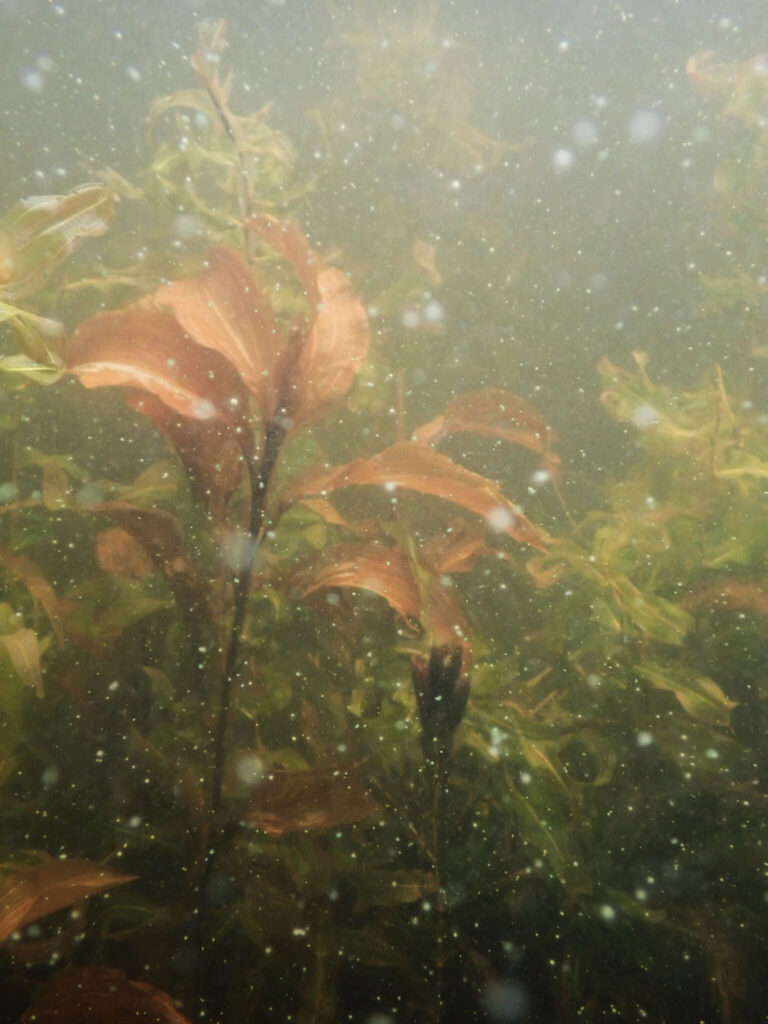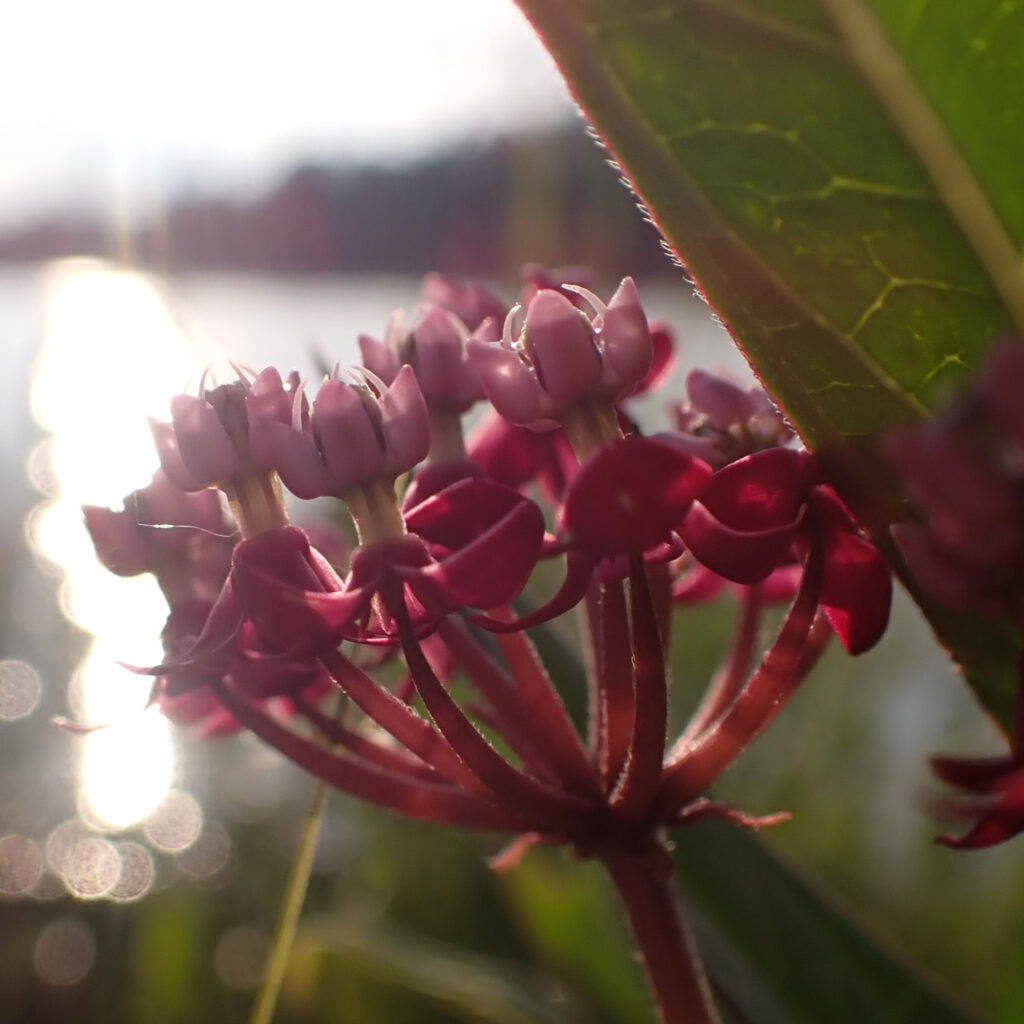By Emily Stone
Naturalist/Education Director, Cable Natural History Museum
The golden evening sun and calm water were too delicious to miss. Decked out in full bug jacket and long pants, I hauled my old yellow kayak through the patch of soggy earth and a gauntlet of tiny vampires toward the lake. My head buzzed with thoughts of the day, plans for tomorrow, and the wings of those diminutive Dementors. How are there still so many?
Dip. Dip. Dip. Strong (desperate) paddle strokes took me out into the light breeze. One by one the mosquitos fell back, until finally I could unzip the head net and see properly. I paddled across open water toward a ring of green surrounding a rocky island.
Nosing into the wet thicket, I became transfixed by the way my bright yellow kayak parted the green polka dots of water lily leaves, then the narrow weave of the floating bur-reed, then the spikes of the rushes. Ramrod straight and austere, those gave way to a whimsical patch of upside-down heart-leaves and fuzzy clusters of purple monkey-faced flowers belonging to pickerelweed.
Watching my plastic prow poke through the striking palate of shapes and colors, a line from the poem “Moles” by my favorite poet, Mary Oliver, popped, unbidden, into my head. “Pushing and shoving / with their stubborn muzzles against / the whole earth, / finding it / delicious.”
I inhaled the perfume of basswood flowers on the breeze, and the sweet smell of algae picked up in the wind, and the fresh fragrance of cool evening air tumbling out of the woods. Delicious, yes!
And then my phone buzzed. Why did I even have it on? But the text was from a friend who’s been making me smile, so I tapped on the screen. It wasn’t a long message, just a note to correct a typo in an earlier text. “That should have said I love how you quote Mary Oliver! Not…I love how you Mary Oliver!”
I chuckled—my brain’s own autocorrect had skipped right over the phone’s autocorrect fail. So often, even when someone’s words come out in a funny order, we still know exactly what they mean. But now I re-read the original typo and felt a little fizz of joy. Leaving out a single word had essentially turned Mary Oliver into a verb. I mulled this over. What would it mean “to mary oliver”?
If you’ve read any of her poetry, you know that she was an ecologist poet who wrote with joy and empathy about the natural world. She’s shaped my views on death and beauty more than I can comprehend, and little phrases from her poems overlay my days like the script on artsy greeting cards.
Thinking of her while picking my way around the slippery rocks of the island, I stuck my nose into a patch of hot pink swamp milkweed flowers to inhale their heady scent. “Every day I walk out into the world / to be dazzled, then to be reflective,” wrote Mary Oliver. That seems like a good start to the definition of our new verb.
Backpaddling out of the thicket, I became enamored with the bur-reed leaves. The cells in the dead leaves had hollowed out to create long strips of stained glass. While photographing those held up to the Sun, I noticed some funny bumps on a live leaf, each with two long tails like the bunny ears on my first TV. When I picked up that leaf, I found that they each extended a long oval capsule into the water on the underside. Often, when you are mary-olivering, “if you notice anything, / it leads you to notice / more / and more.” (If you know who these eggs belong to, please tell me!)
As I paddled on through the shallow bays of Lake Namakagon, the ghostly shapes of aquatic plants appeared and disappeared beneath me. To get a better look, I dipped my waterproof camera beneath the surface and blindly took photos in the water. I’d have to enjoy them later, after dark, on my computer screen. “I look; morning to night I am never done with looking.” Wrote Mary Oliver, and although I’m pretty sure she wasn’t talking about uploading photos, I think it counts. (Watch for the results on our social media feeds.)
Finally I made it to a patch of white water lilies just starting to bloom. In a scene straight from her poem “The Ponds,” a muskrat swam past. I dipped my camera below the surface and snapped away, then brought it up and peered at the screen. The lily was luminous. Light from above filtered through the white petals. Specks of algae surrounded it like fairy dust.

But the flower wasn’t perfect. Algae and tiny eggs had clung to its surfaces and the odd detritus of a productive lake mucked up the water. Nearby, the water lily’s leaves were full of holes chewed by beetles. It’s not just art, it’s habitat. Still, it was worthy of mary-olivering. “I want to believe that the imperfections are nothing— / that the light is everything—that it is more than the sum / of each flawed blossom rising and falling. And I do.”
I mary-olivered all evening. I plan to mary-oliver every day. “Tell me, what is it you plan to do / with your one wild and precious life?”

Emily’s award-winning second book, Natural Connections: Dreaming of an Elfin Skimmer, is available to purchase at www.cablemuseum.org/books and at your local independent bookstore, too.
For more than 50 years, the Cable Natural History Museum has served to connect you to the Northwoods. Our new exhibit: “The Northwoods ROCKS!” is open now! Our Summer Calendar of Events is ready for registration! Follow us on Facebook, Instagram, YouTube, and www.cablemuseum.org to see what we are up to.
